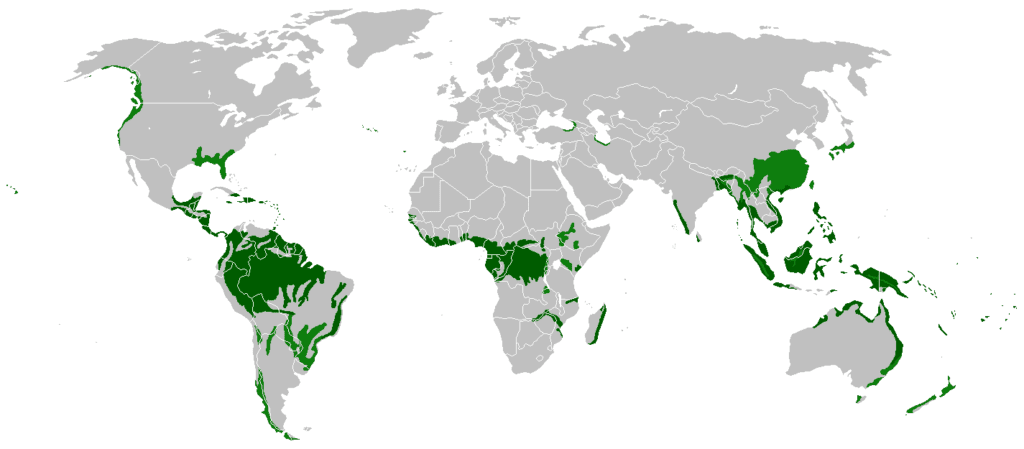Tropical Rainforest Biome
The tropical rainforest biome is an ecosystem that covers about 7% of the earth’s surface. The biomes of tropical rainforests indicate ecological conditions for the growth of plants and animals. As the region has high temperatures throughout the year combined with a large amount of rainfall, thus provides a favorable environment for organism growth. The tropical rainforest biome, in the Amazon basin, is known as Selva.
What is a Tropical rainforest?
A tropical rainforest is a forest having closed-canopy trees growing within 28° north or south of the equator. Receiving an average of 200 cm of rainfall per year. The biomes and abiotic factors of the tropical rainforest are described below.

Location & Extension
Tropical rainforest biome is mainly located along the equator of the 10° north latitude to 10° south latitude. Some of the major tropical rain forests are as follows
- The Amazon Basin of Central America and the east coast of Brazil.
- Congo Basin of Africa and the eastern part of Madagascar.
- Indo- Malaysia region, especially Sumatra, Java, Bali, Borneo, and Guyana.
- The west coast of India and the south-east part of China.
Climate
The tropical rainforest biome mainly depends upon heavy rainfall and high temperatures.
- The Sunray falls vertically through the year therefore the annual temperature is very high.
- The average annual temperature in this region is 27°c and the average annual rainfall is 200cm.
- There is no change in the season due to the extreme temperatures. Therefore, the tropical rainforest has summer throughout the year.
- The annual average relative humidity in these regions varies from 77-88 %.
- It rains with thunderstorms almost every day at noon. Rainfall is mostly from the cumulonimbus cloud in the circulation process.
- The velocity of the wind is higher at the upper levels of the forest, but at lower levels, it decreases.
Below is a table describing the month-wise temperature and rainfall in the tropical rainforests.
Annual temperature (°C) & rainfall (cm) in Tropical rain forest
| Month | Jan | Feb | Mar | Apr | May | Jun | Jul | Aug | Sep | Oct | Nov | Dec |
| Temperature (°C) | 26.4 | 26.7 | 26.8 | 27.2 | 27 |
26.6 | 26.7 | 27.5 | 27.8 | 28 | 27.5 | 26.8 |
| Rainfall (cm) | 227 | 108 | 132 | 164 | 297 | 347 | 281 | 168 | 93 | 111 | 178 | 325 |
Natural Vegetation
There are many different types of trees in the tropical rainforest biome. According to scientists, there are about 100 to 300 species of tree gathers per hectare in South America. About 70% of the world’s total tree plants belong to the tropical rainforest. The main trees in this forest are Mahogany, Ebony, Rosewood, Ironwood, Venus flytrap, Lichen, Moss, Live oak, etc. Also trees like Pineapple, Palm tree, Orange, Orchid, etc.
Tropical rainforest biome vegetation is seen at five levels
First layer
At this layer, the tallest trees are located. The leaves of these trees are located in a way that looks like a canopy. The height of the trees is more than 30 to 60 meters. These trees are as strong as tall. So it is also called the dominant layer.
Second layer
This layer consists of trees ranging from 25 to 30 meters. It is called a codominant layer.
Third layer
The trees are quite small with wide leaves in the third layer. These trees range from 15 to 25 meters in height.
Fourth layer
The height of the trees here is within 5 meters.
Fifth layer
This layer is called a ground layer. Thus, the height of the plants does not exceed 1 to 2 meters.
Some of the interesting features of the Tropical rain forest biome
- There are more than one species of trees that thrive together in this forest.
- The humid and warm weather of this forest helps in the fast growth of the plants.
- The trees form a canopy, spreading the branches like open umbrellas on top. As a result, sunlight cannot penetrate the forest. Therefore, a damp environment is created in the forest. And that is why it is called the Land of Eternal Twilight Zone.
- Most of the plants have Buttresses and Spindly roots.
- The tropical rainforest has characteristic wide and green leaves.
- These forests provide 40% of the world’s total oxygen.
- About 1/4 of the tree species are used to make herbs.
Animal life in tropical rainforest biome
The fauna of tropical rainforests varies from different regions of different countries.
South America
Insects
Morpho butterfly, Julia butterfly, Monarch butterfly, and millions of insects can also be seen.
Mammals
Sloth, Jaguar, Opossum, Howler monkey, Spider monkey, Capybara, Ocelot, Tapir, etc.
Birds
Quetzal, Macaw, Tinamou, Hummingbird, Ovenbird, Antbird, Flycatchers, Puffbird, etc.
Amphibian
Anacondas, Iguanas, Poison frogs, Caiman, Curl snakes, etc.
Fish
Electric eel, Piranha etc.
South Asia
Mammals: Tarsier, Orangutan, Siamang, Gibbon, Colobines monkey, Tiger, Binturong, Flying fox, Bamboo rat, etc.
Insects: Queen Alexandra’s birdwing butterfly, Saturn butterfly, etc.
Birds: Treeswift, Leafbird, Fairy-bluebird, Wood swallow, etc.
South Africa
Mammals: Antelope, Bonobo, Gorilla, Chimpanzee, Mandrill, Pygmy hippo, etc.
Birds: Congo peafowl, African Gray parrot, etc.
Interesting characteristics of animals found in the tropical rainforest biome
- The growth of the plants in this forest is rapid, so the animals do not migrate elsewhere in search of sufficient food.
- Animals in the region live in trees because of a lack of sunlight, damp floors, extremely dense shrubs, etc.
- About 40 to 100 animals can be seen in a hectare forest here.
- Lots of fish, Crocodiles, and hippopotamuses, are seen in the rivers of the region.
Tropical rainforest biome abiotic factors
All of the non-living things in an ecosystem come under abiotic factors. If one factor is removed or changed, it can affect the entire ecosystem and all of the organisms that live there. Abiotic factors of the tropical rainforest include soil, sunlight, rain, and rocks. These are described below.
Soil
The soils in this region are not particularly fertile. Because of dense forests, raindrop does not fall directly to the ground. Therefore, no erosion is there. The main soils in this region are laterite soil. Therefore, is unsuitable for agricultural work. The amount of organic matter in the soil is very low due to excess rainfall. The surface of the soil is only 1 to 2 inches thick.
Rain
Since we are talking about tropical rainforests, rainfall is an important part of the discussion of abiotic factors. Rainforests are considered to be the wettest places on earth, some getting rain every day. Dense water vapors are usually in the same region because of the different weather patterns around the rainfall, meaning that the rains have effectively their own mini-climate. Through the consistent amounts of rain, rainforests generally stay humid all year, aiding in the decomposition of dead organisms on the forest floor. Rainfall also erodes the rocks, usually becoming very smooth and round in tropical rainforests.
Sunlight
The amount of sunlight in the tropical rainforest varies depending on how tall a tree is. Although tropical rainforests receive 12 hours of sunlight daily, less than 2% of sunlight reaches the ground. The tropical rainforest has thick vegetation, often forming three separate layers- the canopy, the understory, and the ground layer.
Rocks
The soils of the tropical rainforest are mainly derived from granite rhyolites and morphological sedimentary rocks.
Human Activities of Tropical Rainforest Biome
The tropical rainforest area is about 17 million square km. And biomass of this region is 45kg/sq. m. Because of the unhealthy climate, inappropriate soil, and poor communication systems, special gatherings of people in this region are not noticed. Some primitive civilized people live in tribal communities such as the Pygmy, Bantu, etc. As a result, human activities are not seen here. Farming is not done due to unhealthy environment, inappropriate climate, disease-prone insects, etc. The main functions of the indigenous people are to collect the fruits of the forest and hunt the animals. However, the world as a whole has taken various stapes to overcome the above-mentioned difficulties.
